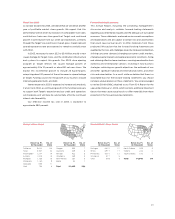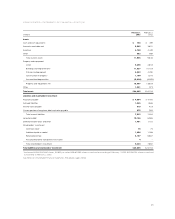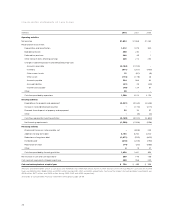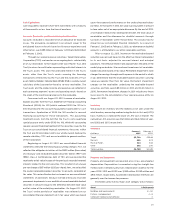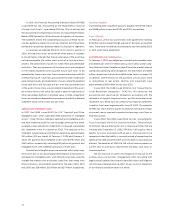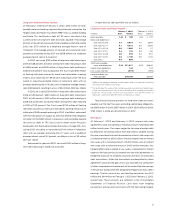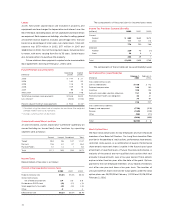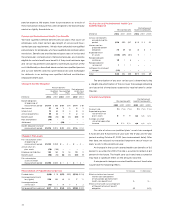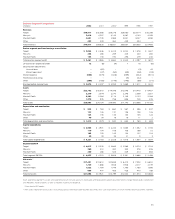Target 2002 Annual Report Download - page 31
Download and view the complete annual report
Please find page 31 of the 2002 Target annual report below. You can navigate through the pages in the report by either clicking on the pages listed below, or by using the keyword search tool below to find specific information within the annual report.
Cash Equivalents
Cash equivalents represent short-term investments with a maturity
of three months or less from the time of purchase.
Accounts Receivable and Receivable-backed Securities
Accounts receivable is recorded net of an allowance for expected
losses. The allowance, recognized in an amount equal to the
anticipated future write-offs based on historical experience and
other factors, was $399 million at February 1, 2003 and $261 million
at February 2, 2002.
Through our special purpose subsidiary, Target Receivables
Corporation (TRC), we transfer, on an ongoing basis, substantially
all of our receivables to the Target Credit Card Master Trust (the
Trust) in return for certificates representing undivided interests in
the Trust’s assets. TRC owns the undivided interest in the Trust’s
assets, other than the Trust’s assets securing the financing
transactions entered into by the Trust and the 2 percent of Trust
assets held by Retailers National Bank (RNB). RNB is a wholly owned
subsidiary of the Corporation that also services receivables. The
Trust assets and the related income and expenses are reflected in
each operating segment’s assets and operating results based on
the origin of the credit card giving rise to the receivable.
Concurrent with our August 22, 2001 issuance of receivable-
backed securities from the Trust, Statement of Financial Accounting
Standards (SFAS) No. 140 (which replaced SFAS No. 125 in its
entirety) became the accounting guidance applicable to such
transactions. Application of SFAS No. 140 resulted in secured
financing accounting for these transactions. This accounting
treatment results from the fact that the Trust is not a qualifying
special purpose entity under SFAS No. 140. While this accounting
requires secured financing treatment of the securities issued by the
Trust on our consolidated financial statements, the assets within
the Trust are still considered sold to our wholly owned, bankruptcy
remote subsidiary, TRC, and are not available to general creditors
of the Corporation.
Beginning on August 22, 2001, our consolidated financial
statements reflected the following accounting changes. First, we
reflected the obligation to holders of the $800 million (face value)
of previously sold receivable-backed securities (Series 1997-1 and
1998-1, Class A Certificates) as debt of TRC, and we recorded the
receivables at fair value in place of the previously recorded retained
interests related to the sold securities. This resulted in an unusual
pre-tax charge of $67 million ($.05 per share). Next, we reclassified
the owned receivable-backed securities to accounts receivable at
fair value. This reclassification had no impact on our consolidated
statements of operations because we had previously recorded
permanent impairments to our portfolio of owned receivable-backed
securities in amounts equal to the difference between face value
and fair value of the underlying receivables. On August 22, 2001,
the Trust’s entire portfolio of receivables was reflected on our
consolidated financial statements at its fair value, which was based
upon the expected performance of the underlying receivables
portfolio. At that point in time, fair value was equivalent in amount
to face value, net of an appropriate allowance. By the end of 2001,
a normalized relationship developed between the face value of
receivables and the allowance for doubtful accounts through
turnover of receivables within the portfolio. This process had no
impact on our consolidated financial statements. As a result, at
February 1, 2003 and at February 2, 2002, our allowance for doubtful
accounts is attributable to our entire receivables portfolio.
Prior to August 22, 2001, income on the receivable-backed
securities was accrued based on the effective interest rate applied
to its cost basis, adjusted for accrued interest and principal
paydowns. The effective interest rate approximates the yield on the
underlying receivables. We monitored impairment of receivable-
backed securities based on fair value. Permanent impairments were
charged to earnings through credit expense in the period in which
it was determined that the receivable-backed securities’ carrying
value was greater than their fair value. Permanent impairment
charges on the receivables underlying the receivable-backed
securities portfolio were $89 million in 2001 and $140 million in
2000. Permanent impairment charges in 2001 include only those
losses prior to the consolidation of our special purpose entity on
August 22, 2001.
Inventory
We account for inventory and the related cost of sales under the
retail inventory accounting method using the last-in, first-out (LIFO)
basis. Inventory is stated at the lower of LIFO cost or market. The
cumulative LIFO provision was $52 million and $64 million at year-
end 2002 and 2001, respectively.
Inventory
February
1,
February
2,
(millions) 2003 2002
Target $3,748 $3,348
Mervyn’s 486 523
Marshall Field’s 324 348
Other 202 230
Total inventory $4,760 $4,449
Property and Equipment
Property and equipment are recorded at cost, less accumulated
depreciation. Depreciation is computed using the straight-line
method over estimated useful lives. Depreciation expense for the
years 2002, 2001 and 2000 was $1,183 million, $1,049 million and
$913 million, respectively. Accelerated depreciation methods are
generally used for income tax purposes.
Estimated useful lives by major asset category are as follows:
Asset Life (in years)
Buildings and improvements 8 – 50
Fixtures and equipment 4 – 8
Computer hardware and software 4
29






